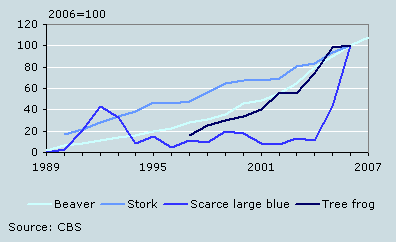Approximately half of reintroduction programmes successful

Approximately half of reintroduction programmes for animal species which had altogether or partly disappeared from the Netherlands have been successful.
Nineteen species reintroduced
Nineteen species have been reintroduced into the wild over the past thirty years to restore populations. Beaver, hamster, raven, stork and scarce large blue were successfully reintroduced into the wild, although – after an initial increase – the raven population is no longer growing.
Beaver, stork, scarce large blue and tree frog after reintroduction

The reintroduction process of the dusky large blue and the small pearl-bordered fritillary was less successful and attempts to reintroduce grayling and heath fritillary failed. For a number of species it is still early days to establish whether the reintroduction programme was successful or not.
Raven and dusky large blue after reintroduction

Breeding programmes
Species which are reintroduced nationwide are invariably brought in from wild populations abroad. The genetic make-up of the population should match as much as possible with the extinct Dutch population. Breeding programmes are set up to re-establish numbers of endangered species, such as hamster and black grouse. For reintroduction of indigenous species, Dutch populations are also used.
Reintroduction programmes successful

Century-old practice
Reintroduction of indigenous and exotic animals into the wild has a long history. In the past, mainly species hunted or fished down to near extinction, like wild boar, red deer, fallow deer, mouflons, rabbits, partridges, pheasants and pike perches were reintroduced. Today, nature conservation is the main motive for reintroduction.
Lodewijk van Duuren (CBS) and Frank Stavast (Ministerie LNV)